An interview with Christopher Hector
Dr Thomas Nissen became the breeding director of the Holsteiner Association in 1989. He joined the Holsteiner Association in 1988 after completing his Agriculture degree at Kiel – the appointment was a logical next step since his thesis topic was The mare performance test and fertility of the Holsteiner horse.
One of Dr Nissen’s primary concerns has been the modernization of the Holsteiner horse using English Thoroughbreds, and he has brought into the breeding program stallions like Königspark xx, Grundyman xx, Sir Shostakovich xx, Barnaul xx, Mytens xx, Parco xx, Esteban xx and Heraldik xx. He also opened the doors to foreign blood, primarily using French stallions, with Quidam de Revel now a major influence in Holstein. Famous sport horses such as Donnerhall and much later, For Pleasure and Stakkato were approved in breeding trials under his leadership. I caught up with him at Neumünster show, in the heart of Holstein, and recorded this far ranging and frank interview.
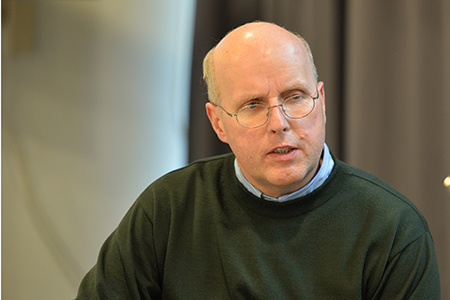
Talking to breeders and breeding officials all over Europe, breeding is way down on previous years, is this downturn affecting the Holsteiner Association?
“Yes. In Holstein, we have had a very good market and the breeders could sell foals for good prices, until three or four years ago, when things started to change, and the numbers started to go down every years, about 10-15%. I think it is now down about 40% in the last three or four years.”
Is this the effect of the global financial crisis?
“I think the financial crisis was one factor, but we should be aware that there is a big change in social development, we have to recognize this. In Europe, society has changed, the birth rate goes down and the young people have many sport alternatives, riding and the whole horse industry has been affected by this. The time we had will not come back. A new century has begun, and we as breeding associations, and also our breeders, have to accept this, and make new breeding programs to fit this new situation.”
Will there be a great reduction in mare numbers – like there was at the end of World War II?
“I think in every crisis, you also have big chances to find a higher level in the quality, and that is our aim. We say to our breeders, okay, the situation is as it is, and the chance to take a profit out of this is to become better and better in the quality. We have a high level of quality in jumping in our breeding population, but when I started 20 years ago, we had 4000 brood mares, then it grew and grew, very quickly, especially from 6000 to 9000, and I think this period was too short to maintain the good quality. They produced many horses, but not with enough quality, and now it goes on, and we have around 7000 brood mares and that is a good basis, maybe six or six and a half, is also good. A lot of breeders still own their brood mares, but they will not cover them. So we have 7000 broodmares but we will have around 3000 foals each year. We can only produce as many foals as the breeders can sell, but we say to our breeders, it is necessary that you hold on to your quality mare, and now it is time to bring your quality mare to a good stallion because in four years, quality riding horses will become more expensive because the numbers have gone down.”
“In Holland, Scandinavia, France, all the breeding regions, the covering rate is down 50% so in a few years we will have a small number of quality performance horses.”
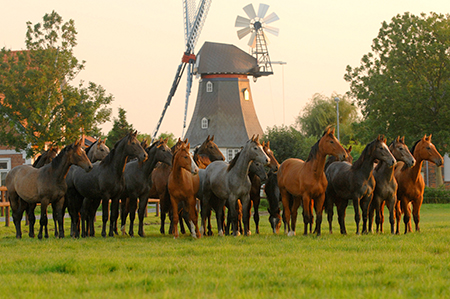
Photo: Janne Bugtrup
The strength of Holstein in the past has always been sticking to breeding jumping horses – will that be the strength in the future?
“In the last ten, fifteen years, the other breeds have bought good genetics from the Holsteiner and a lot of very good stallions have gone to those areas, so the jumping quality grows and grows in those places – that is a problem for us. But I think it is the same situation if you have a factory for cars, if you produce a good car, like a Porsche or a Mercedes, an Audi, you have a marque, a brand image, and I hope that the marque of the Holsteiner is very popular all over the world and all breeders, who want to breed jumping horses will come back and take the original Holsteiner again. It is necessary that we have very good breeding programs to produce more interesting horses with a better quality than anyone can find elsewhere. You can drive a Japanese car if you want, but for the people who want to express their personality, there is an identification with the branding of certain top cars, and I hope that the riders and the trainers will continue to regard the Holsteiner as the best.”
For twenty, thirty years, the Holsteiner mix has been a variation on two chords: Cor de la Bryère and Capitol with the occasional Thoroughbred, will this continue to be the recipe for the future?
“The Holsteiner population is a clear population, because we have unique mare lines – we will not take any mare lines from the French or the Dutch, Hanoverian, Westfalia, whatever. We only take Holsteiner mares in our breeding books, and all the mares in our books have a Stamm number. The older mare lines have numbers and you can follow those numbers through and learn something about the quality of the Holsteiner breed. We will not change that.”
“It is only some stallions that we take from outside. Thoroughbred stallions, we need the Thoroughbred to make the horses intelligent, tough and modern. We are always looking for foreign blood, and we prefer stallions from France and we are looking for them, but it is difficult because every breed, the Dutch, the Belgian, all the German breeds, they go around the world looking for interesting blood, and with the globalization and the flow of information on the internet, it is very hard to find an exclusive source of new blood anywhere. We need to add fresh influences to our population with stallions from outside.”
Were you surprised with the success of Baloubet? I remember one of your famous breeders, Mr Thormähen, saying to me, I used Baloubet, but I hated the foals… Now maybe he thinks differently!
“We took Baloubet years ago in our breeding program. It is not easy, he is a little bit of a strong, heavy type with not so good a face, and he needs special mares. There is no discussion, he is one of the best, if not the best, producer of jumping horses in the world. We look for this blood, our Association has a son, Baracuda, out of a Contender mare. He is a lovely type, he has a good face, not too heavy, he is a good jumper and we try it with him. We have approved grand sons, like Balou’s Bellini, by Paul Schockemöhle’s stallion, Balou du Rouet. It is a very nice stallion, he is out of a Holsteiner mare by Lord Incipit.”
“I hope we will get some benefit from these stallions, but you cannot just hope that Baloubet du Rouet will bring success in the Holsteiner population, he can play a small part.”
How important do you think it is that a stallion should be a good competitor himself? Baloubet was a fabulous competitor, but Balou was pretty ‘normal’, is that a big factor for you when you look at a stallion?
“I think there is also a danger in that we live in this era of globalization, we live in a total information society, and the danger is that only a handful of breeders can handle this information. A lot of them look and say, oh how nice, he is in competition, that is the stallion for my mare, they look on the internet for the dealer and buy the semen on the internet. They never look at the stallion live, and say, okay, is he the right stallion for my mare or not? I think that is necessary. If you go back 30 years or so, there was no artificial insemination, and the breeders had to go to the stallion station to look at the stallion, okay this stallion is right for my mare – and I think we bred better horses than today. Today everyone says the best stallions are in competition, Baloubet, Quick Star, Kannan…”
Casall…
“Casall is a slightly different situation, I will come back to him, but sometimes the stallions are only good competition horses and not good in breeding. We know this because we had the stallion, Silbersee, he was the perfect sport horse, lovely type, Michael Rüping won the Hamburg Derby and many Grand Prix with him, but he was no stallion. His offspring were very different types, different performance, and today we have no influence from him. But the breeders only see the competition success on the TV and they think that is the right stallion, and when he is popular, they hope, oh if I have a foal from this stallion, it must be interesting to the buyers. But I think only the quality of the horse will bring success, not the pedigree. That is a problem today, there are a lot of stallions that are only popular stallions, but not the best breeding stallions…”
Is this partly because there is so much mis-information on the internet. I get emails, progeny of my stallion have won so many Grand Prix in the past 12 months, but when I go to the database, this is not true, total lies, but once it is on the internet it gets repeated, so it must be true…
“No body controls this information, and that is one of the biggest problems, so there is a lot of misleading information, lots of good marketing, it is a chance for the stallion owners to market their stallions, but the breeders will not have success with all these nice pictures and clever marketing…”
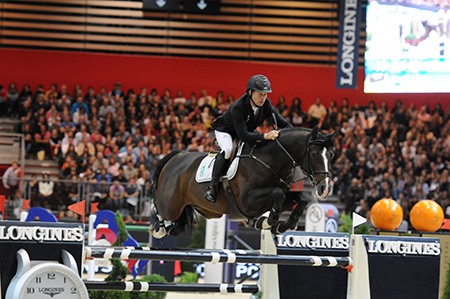
Casall
“I will come back to Casall because Casall is in my eyes, for the Holsteiner population, a special stallion because he is a successful horse in competition but he also does a fantastic job as a breeding stallion. He is himself not the perfect type you might dream about. He is a lovely horse but his genes and his mother line is one of the best in the Holsteiner population. There are lots of good competition horses and stallions on that mother line. It is not so big a mother line, it is a small line but always with very good quality in the horses.”
“Casall is by Caretino, who was a Caletto II son – one of very few because Caletto II only bred for a few years before he died, but he made a very good job, and of the few stallions, Caretino was the best of Caletto II. Casall has a Lavall mother, and Lavall is Landgraf and Sacramento Song. So we have the influence of the Thoroughbred by Sacramento Song, and Landgraf’s sire, Ladykiller, and Caretino by Caletto II by Cor de la Bryère, by the Thoroughbred, Rantzau. In the background a lot of Thoroughbred, combined with a good mother line and good performance stallions. Landgraf, and Sacramento Song, who not only brought Thoroughbred influence, but also good jumping quality. Behind this is the Ramzes’ son, Raimond, and influence of Ramzes was enormous in the Holsteiner population, especially for performance horses – Capitol is one of the stallions with the greatest influences of Ramzes blood in his pedigree. This combination produces the high genetic level of Casall.”
What particular mares does Casall need?
“You have to look a little bit that they are long in their legs, this is the type Caretino needs and also Casall needs. They should not be too heavy, and then he will do a good job on different backgrounds of pedigree and blood. Always the combination is good in Holstein if you find in the background the blood of Cor de la Bryère or Ladykiller. Casall should find a lot of mares with this in their pedigrees in Holstein.”
Looking at the new stars, I know that Diarado was the number one stallion on the German FN breeding values, but looking at the two colts that were not approved at the KWPN licensing, they looked a little pretty but without scope – and Diarado has yet to appear on the international circuit, while Casall had already won a Grand Prix when he was nine years old…
“I think with Diarado it is another situation. Casall when he was young and came to our approval, he was a little small, not so perfect like Diarado, and the breeder thought that he had a nice pedigree, so we try him – but not like Diarado, Diarado was a champion when he came to the approval. The whole jumping world applauded Diarado, he was one of the best stallions we have had at the approvals in Holstein, he was such a perfect type, and he was a very good jumper, the spectators gave him a standing ovation. He had an enormous background when he started his breeding career, and that was not so easy for the owner, for the rider, and a lot of breeders wanted to use his semen, he had hundreds of mares and it was hard to manage the covering and the sport career. They tried, and I think he was quite good as a young horse. We had him in Holstein a few weeks ago in a stallion presentation, and he did it very well, he is a good jumping horse. If he has that last capacity for jump a Grand Prix, we have to wait and see. I don’t know if the training of the rider goes in this direction, in the last few years, the breeding has been the main point, not the sport career – maybe they change it now and work with frozen semen. He makes a very good job as a breeding stallion, we have a lot of good offspring, we approved some sons – we have a very interesting four year old son, Dinken out of a Caretino / Cassini mare, he is a perfect jumper with a lot of capacity, and we have a lot of good daughters in the performance test of the young mares.”
“I can understand why Diarado has such a high breeding value, based on the mare tests, and the 70 day test of the stallion, and there are a few offspring in competition. I think in the years to come we will see his offspring competing at the higher levels.”
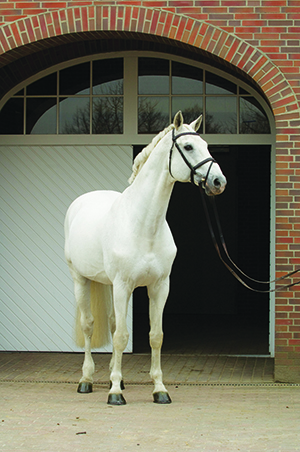
Corrado
But it is true that some of the greatest jumping stallions of all time have been rejected when they came to their licensing and only licensed when they succeeded in the sport…
“Corrado was one… but that is one of our aims of our Association, to bring stallions in the top level in the sport, now Casall, we also have Quintero (Quantum / Chaimonix) who is with Rolf-Goran Bengstsson. He also has several younger stallions in his stable that he is trying, and we hope there is one or two that can come into the highest level of the sport, but it is very expensive to bring stallions to this level, and it is a long and a hard way for an Association because of the money involved. We have to find sponsors, like Mr Romo at La Silla, or now the Danish stud farm, Stutteri Ask with Casall. Not every stallion is able to go to this level, it is not just the question of capacity, there are many factors that must come together for a stallion to reach this top level, a big influence is the rider, you need a top rider to reach this level. It is not a problem of the genetics, there are many other factors that must come together.”
We have seen a number of very important influences in Holstein, the Thoroughbreds, the influence of Cor de la Bryère, what would you add to the mix now if you could?
“I think we are working now always with a high level of quality in terms of type, it is difficult to always make the type better and better. We have a breeding aim, it is on the paper, but it is also always in our heads, we always look for the perfect horse – but you will never find the completely perfect horse. You always have to weigh up the different points. I would say with Diarado, he was the perfect type – he was a type that we aim to find. What is interesting is that he is also out of a very good mother line, one of the best. His mother is by Corrado, who was a perfect international jumper, and then the combination with Diamant de Sémilly. Diamant de Sémilly is not known as an easy stallion because he is a very heavy type and produces offspring with a heavy type, but with Diarado, it was perfect. That is a fantastic product, and with him we have reached our aim, but we try it not only with one horse, we try it every year with a lot of horses.”
“For me, it is interesting to develop the Holsteiner breed with the influence Thoroughbred and some special good performance blood.”
Ludwig Christmann did a study that found a negative correlation between good marks for conformation and jumping ability…
“Okay that may be, but we try to combine both. We know we have to make compromises if we want a perfect performance horse – then you will not have a horse that is correct in every respect. When a horse is perfect in jumping, like Corrado, when he was young, very narrow, tall, not the perfect stallion type but he was a jumper with such capacity that we had never seen before, so we say, okay, if the stallion can give these genes into the next generation, then he is interesting as a stallion for us. And he could, and he did, do it for us. He produced a lot of offspring that jumped at the higher level. In his time he was a famous stallion but the breeders knew that if they used Corrado, they will not get the perfect type, the topline a little bit long, a little bit deep, not so correct and they are not so easy to handle, they are difficult, but they had a lot of scope and capacity. If you want to get this into your breed, then it is good to go to Corrado, but if you want correct horses, a little more easy to handle, then you have to take another, perhaps Casall, they are better in the head. That is breeding and we will never reach the aim and say, okay, now we have everything.”
What is your feeling about the use of clone stallions?
“We in Holstein are not friends of cloning because cloning is not a breeding process for the future. You clone a good competition horse, or a stallion like Levisto or Chellano, but it is a philosophy of Mr Melchior, and we accept this, he can do it, but we don’t want it. For me, there are so many questions, and we get no answers, not from the government or from the EU. For me, the first question, is, who is the breeder of a clone? Is Mr Melchior, if he makes a clone, the breeder? He says ‘no, I will not be the breeder, the breeder is the original breeder’ – but did he ask the breeder of the original, ‘do you agree that we make a clone? I will pay you some money because you had the idea of the original, and if you agree, I will make a copy.’ He doesn’t do that, he doesn’t ask anybody. The breeder of the original has the idea and in animal breeding it is not possible like it is with plant breeding to have a patent, but in animal breeding we don’t have rules like that, and we need them.”
“That is the first step, but then the question is, is cloning an interesting breeding method? I think not, it is against the small breeder. People like Mr Melchior with a lot of money, they can pay for clones, but it doesn’t help the farmer breeders that we have in Holstein. So we don’t allow clones in our breeding program.”
You have mentioned several times the need for Thoroughbred blood, but there is a counter argument from people like Arnaud Evain that if a drink is 40% alcohol and you mix it with another 40% alcohol, then you still have the same percentage of alcohol, and he argues it is the same with horses, you can have the proportion of Thoroughbred without using Thoroughbreds…
“I think we have to put Thoroughbreds into our population with a lot of experience and feeling, and this feeling, only the breeder has. Now the problem is that the breeder wants to sell his foals, and in this situation where the market is very difficult, it is more difficult to sell a foal by a Thoroughbred. If you offer a foal by Baloubet or Casall, or you offer a foal by Fragonard, one of our Thoroughbred stallions, the buyers say who is Fragonard? I want a foal by Baloubet… If they get a filly by the Thoroughbred, it is interesting for the breeder, because they can bring it into their mother line, and you can breed very well with a half blood mare because many of the most famous jumping stallions are heavy and they need a half blood mare. So there is no problem with a filly foal but with a colt foal it is more difficult.”
“The thinking of Mr Arnaud who says there is enough Thoroughbred in our population, I don’t think that is right because when we go to France to look at foals, we miss the influence of the Thoroughbred because the French horses are often very heavy. For us, it was better to find a stallion like Cor de la Bryère who was by the Thoroughbred, Rantzau, but you will not find this now. You will find a little bit the influence of Laudanum, sometimes Hand in Glove, but Hand in Glove was more the heavy type, and then you have to go back to stallions like Furioso or Rantzau but they are not in the second or third, more in the fourth and fifth generation, and that is too much in the background.’
“I think every generation has to use Thoroughbred stallions, if they don’t do it, the Thoroughbred influence will go back and back and back. The thinking of Mr Evain was if we have 50% in each horse and we cross, we always have 50%, I think that is a dream but it didn’t happen. We see in the Holsteiner population, if we have periods of five or six years without Thoroughbred then you can see that the mares and the foals become more heavy, and we need always the influence of the Thoroughbred.”
The search goes on…
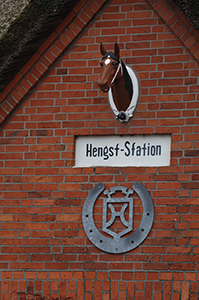

This is very exciting as I have a 4 year old KWPN Stallion, Five Kings HsH (Berlin x Diamant de Semilly x Quidam de Revel x Landgraf) that has already produce marketable and good looking offspring, has very high motility fresh and frozen, incredible scope in the chute, leggy, fancy movement, chrome America loves, and the modern sport horse look with a very good temperament. I have had breeders breed their mares to him for dressage, hunter, jumpers, and eventers babies. The breeders however are more concerned with what the stallion is doing at the shows; like this article states by saying a horse is doing well in competition isn’t always going to prove himself as a worthy stallion for breeding. I have always said the quality of his offspring will not change based on what he is doing himself, unless he gets better mares to breed to based on performance. I am excited to see the registries open up to other breeds, however it is leaning towards more of a registry/association (like new registries opening up-North American Stud Book) rather than a breed. Hanoverians and Holsteiners were always easy to distinguish b/c their breed books were so closed to only their breeds, but now with the books opening up to other breeds it will be hard to determine a Hanoverian or Hoslteiner in looks alone. However I am all for it as it will open up the gene pull and make very desirable sport horses.
Great interview! Some excellent information here. Interesting to read that before AI breeders were breeding better horses because they went to see the stallions in the flesh. Now with AI we chose the ones that most likely have been marketed the best. IN Australia of course we basically rely totally on info from the web, as it is impossible to travel to see the stallions of your choice. Just financially not feasible. I live in WA and even travelling to the East coast to see stallions there is not always possible.
As a breeder with Holsteiner mares as a base I am taking away quite some usable information 🙂